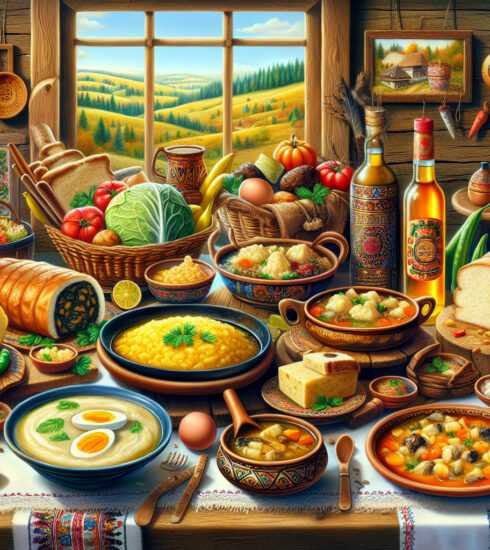Uncover the Hidden Gems: Rediscovering the Forgotten Flavors of Maramureș Cuisine
Maramureș Delights: Exploring the Forgotten Flavors of Maramureș Cuisine
Welcome to Maramureș, a region nestled in the heart of Romania, known for its untouched beauty, rich cultural heritage, and delicious cuisine. Maramureș cuisine is a hidden gem waiting to be discovered by food enthusiasts and explorers from around the world. With influences from neighboring countries like Hungary and Ukraine, Maramureș cuisine offers a unique blend of flavors that will leave you craving for more. In this article, we will delve into the untapped treasures of Maramureș cuisine, exploring the forgotten flavors that make this region a culinary paradise.
A Taste of Tradition: The Essence of Maramureș Cuisine
Maramureș cuisine is deeply rooted in tradition and is a reflection of the region’s rich agricultural heritage. In Maramureș, food is more than just sustenance; it is a celebration of community, family, and cultural identity. The cuisine pays homage to the natural resources of the region, with an emphasis on locally-sourced ingredients and age-old cooking techniques.
One of the defining characteristics of Maramureș cuisine is its simplicity. The dishes are often prepared using humble ingredients such as potatoes, onions, cabbage, and various types of meat. The recipes have been passed down from generation to generation, with each family adding their own touch to create unique flavors.
One popular dish that exemplifies the essence of Maramureș cuisine is “Sarmale.” Sarmale are cabbage rolls stuffed with a mixture of ground meat, rice, and spices, then slow-cooked in a savory tomato sauce. This hearty dish is often enjoyed during festive occasions and is a true symbol of hospitality and togetherness.
Another staple of Maramureș cuisine is “Ciorbă de Burtă,” a traditional tripe soup. This flavorful and hearty soup is made with beef tripe, vegetables, and various herbs and spices. It is often served with sour cream and fresh bread, making it a comforting and satisfying meal.
One cannot talk about Maramureș cuisine without mentioning “Tochitură.” This traditional pork stew is a true delight for meat lovers. The pork is simmered for hours in a rich sauce made from onions, garlic, paprika, and tomato paste. It is often served with polenta and topped with a fried egg, creating a mouthwatering combination of flavors.

Exploring the Forgotten Flavors: Lesser-Known Maramureș Delicacies
While dishes like Sarmale and Tochitură are well-known in the region, Maramureș cuisine offers a plethora of lesser-known delicacies that are waiting to be discovered. These hidden treasures often showcase the creativity and resourcefulness of the locals.
One such delight is “Plăcintă cu Brînză,” a traditional cheese pie. Made with a flaky pastry crust and filled with a mixture of feta cheese, eggs, and herbs, this savory pie is a true crowd-pleaser. It can be enjoyed as a snack or as part of a larger meal.
For those with a sweet tooth, “Cozonac cu Nucă” is a must-try. This traditional Romanian Easter bread is enriched with eggs, butter, and sugar, and filled with a delicious mixture of ground walnuts, sugar, and cinnamon. It is often served during holidays and celebrations, and its sweet aroma fills the air.
Another lesser-known delight is “Ciorbă cu Leșie,” a traditional nettle soup. Nettles are foraged from the nearby forests and cooked with potatoes, onions, and various herbs and spices. This nutritious and flavorful soup is not only delicious but also showcases the unique connection between the people and the natural environment.
For more details and recipes of these lesser-known Maramureș delicacies, check out this article on Romania Trips.
Preserving Tradition: The Role of Maramureș Cuisine in Cultural Heritage
Maramureș cuisine is not just about food; it is a window into the region’s cultural heritage and traditions. The dishes served on Maramureș tables have deep historical and cultural significance, reflecting the identity and values of the local community.

The culinary traditions of Maramureș are often passed down through oral tradition, with recipes and cooking techniques shared within families and communities. This intergenerational exchange ensures the preservation of traditional knowledge and keeps the flavors of Maramureș alive.
Throughout the year, Maramureș hosts numerous cultural festivals and events that celebrate the region’s culinary heritage. These events provide an opportunity for locals to showcase their traditional dishes and engage with tourists and visitors. They serve as a platform for cultural exchange and help promote Maramureș as a culinary destination.
Bringing Maramureș Delights to the World: Culinary Tourism in Maramureș
With its unique flavors and rich cultural heritage, Maramureș has the potential to become a popular culinary tourism destination. Culinary tourists are increasingly seeking authentic food experiences that allow them to savor local flavors and connect with the local community.
Maramureș offers a plethora of opportunities for culinary tourism, from farm visits and food markets to cooking classes and traditional dining experiences. These activities allow visitors to immerse themselves in the local culture, learn about traditional cooking techniques, and savor the flavors of the region.
The promotion of Maramureș cuisine and culinary tourism can have a positive impact on the local economy, creating new job opportunities and supporting the development of small-scale food businesses. It can also help raise awareness about the region’s cultural heritage and contribute to the preservation of traditional knowledge.
Conclusion
Maramureș cuisine is a true treasure waiting to be discovered. From the rich flavors of traditional dishes like Sarmale and Tochitură to the hidden delights of Plăcintă cu Brînză and Cozonac cu Nucă, the culinary heritage of Maramureș is a reflection of the region’s cultural identity and traditions.
By preserving and promoting Maramureș cuisine, we can not only savor delicious flavors but also support the local community and contribute to the preservation of cultural heritage. So, come and explore the forgotten flavors of Maramureș cuisine and embark on a culinary adventure like no other.






